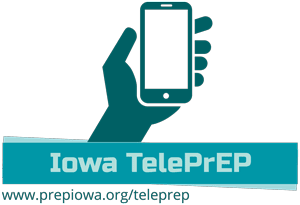TelePrEP
- Need: To prevent new cases of HIV in rural Iowa.
- Intervention: TelePrEP provides preventive care via telehealth and prescription delivery.
- Results: Between February 2017 and August 2020, TelePrEP received 456 referrals, with 403 patients completing an initial visit.
Evidence-level
Promising (About evidence-level criteria)Description
The risk of contracting HIV can be greatly reduced through Pre-Exposure Prophylaxis (PrEP), but the medication must be taken every day and patients need follow-up appointments every 3 months. In addition, rural residents often don't have access to it due to stigma, distance from the nearest specialist, and a shortage of primary care providers willing to prescribe and monitor PrEP.

TelePrEP is a public health-partnered, virtual pharmacist model for PrEP delivery in rural and urban Iowa. TelePrEP partners include the Iowa Department of Health and Human Services and University of Iowa Health Care. From 2018 to 2021, Iowa TelePrEP was funded by the Iowa Department of Public Health through a CDC Demonstration Project award. Upon the expiration of this award, the program transitioned to an internal sustainability model.
Services offered
Project coordinators reach out to at-risk populations, including people with sexually transmitted infections, sexual partners of people living with HIV, and people who inject drugs.
Patients interested in PrEP care can receive video consultations in their own homes.
Patients complete lab work at an outpatient or public health location and receive their medication at their local pharmacy or through the mail. In addition, patients can communicate with their pharmacist providers outside of visits through phone, email, or texting.
Thanks to a Collaborative Practice Agreement (legal agreement that expands the pharmacist's scope of practice) with the medical director, University of Iowa Health Care pharmacist providers can order labs and prescribe and adjust medications based on lab results and patient history/assessment.
Beginning in 2021, the program expanded its scope of practice to provide access to non-occupational post-exposure prophylaxis (nPEP). In 2023, the program began offering DoxyPEP for STI prevention.
For more information about this program, please watch this video:
Results
During the initial test period, TelePrEP served more than 400 patients, of whom more than 90% have started PrEP medication. TelePrEP services are available throughout the state of Iowa. The Health Resources & Services Administration (HRSA) listed the project as a Health Center Promising Practice.
Between February 2017 and October 2018, there were 127 initial video visits with pharmacists and 186 referrals.
For more information:
Chasco, E.E., Shafer, C., Dillon, D.M.B., Owens, S., Ohl,
M.E., & Hoth, A.B. (2021). Bringing Iowa TelePrEP to
Scale: A Qualitative Evaluation. American Journal of
Preventive Medicine, 61(5 Suppl 1), S108-S117.
Article
Abstract
Chasco, E.E., Hoth, A.B., Cho, H., Shafer, C., Siegler, A.J., & Ohl, M.E. (2021). Mixed-Methods Evaluation of the Incorporation of Home Specimen Self-Collection Kits for Laboratory Testing in a Telehealth Program for HIV Pre-exposure Prophylaxis. AIDS and Behavior, 25(8), 2463-2482.
Hoth, A.B., Shafer, C., Dillon, D.B., Mayer, R., Walton, G., & Ohl, M.E. (2019). Iowa TelePrEP: A Public-Health-Partnered Telehealth Model for Human Immunodeficiency Virus Preexposure Prophylaxis Delivery in a Rural State. Sexually Transmitted Diseases, 46(8), 507-512. Article Abstract
Challenges
Since initiation of TelePrEP in 2017, project coordinators experienced the following challenges:
- Raising awareness of PrEP among priority populations in Iowa
- Addressing patients' privacy concerns
- Addressing stigma
- Complexity of payer compliance with cost-sharing protections derived from United States Preventive Services Task Force guidance
Patients with high deductible healthcare plans and uninsured patients face challenges with some of the lab or out-of-pocket costs.
Replication
Create relationships with people and systems already in place. Build on successful work and explore opportunities to leverage existing funding mechanisms to reduce patient barriers and eliminate out of pocket costs.
Understand the community you are trying to reach. Asking patients about their needs and perceived barriers to care keeps patients invested in your project and helps you shape it to best fit their needs.
Be flexible. Create a service that can change rapidly when something doesn't work and strengthen the aspects that are working.

Contact Information
Cody J. Shafer, Lead Prevention Services CoordinatorNuCara Capacity Extension Program
TelePrEP
cody.shafer@hhs.iowa.gov
Topics
HIV and AIDS
· Public health
· Telehealth
States served
Iowa
Date added
August 27, 2018
Suggested citation: Rural Health Information Hub, 2025 . TelePrEP [online]. Rural Health Information Hub. Available at: https://www.ruralhealthinfo.org/project-examples/1029 [Accessed 15 December 2025]
Please contact the models and innovations contact directly for the most complete and current information about this program. Summaries of models and innovations are provided by RHIhub for your convenience. The programs described are not endorsed by RHIhub or by the Federal Office of Rural Health Policy. Each rural community should consider whether a particular project or approach is a good match for their community’s needs and capacity. While it is sometimes possible to adapt program components to match your resources, keep in mind that changes to the program design may impact results.
